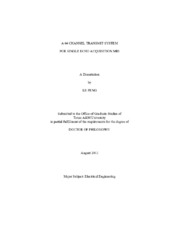| dc.description.abstract | Magnetic Resonance Imaging (MRI) is considered as a slow imaging technique. Various approaches to accelerate MRI imaging have been explored by researchers in the past decades. Earlier gradient based methods have reached the safety limit. Parallel receiving techniques achieve accelerations by reducing phase encoding steps. Among these methods, SEA Imaging achieved the highest possible acceleration by completely eliminating phase encoding. However, SEA imaging is limited to thin planar slices above the array due to the correction needed for the inherent phase cancellation caused by voxel-sized coils. A phase compensation gradient pulse is used for this correction in SEA imaging. This phase compensation is dependent on slice position and thickness as well as the orientation of the array elements, placing stringent restrictions on SEA imaging, limiting its applications. Converting the SEA system into Transmit / Receive (T/R) mode, which is the main purpose of this study, eliminates the requirement for phase compensation gradient because phase departed during transmit is refocused during receiving. Independent amplitude and phase control of RF pulse for each coil of a SEA array is achieved using a low cost scalable parallel transmit system design. The first 64-channel parallel transmitter for MRI in the world is constructed and tested. Software is also developed to control the phase and amplitude of all the 64 channels of RF excitation pulses independently through National Instruments DAQ system. The system consists of vector modulators controlled by digital controlled potentiometers, two-stage amplifiers and T/R switches on the transmit side. All these are combined with newly designed and constructed preamplifiers and the existing 64-channel parallel receivers on the receive side, leading to the only 64-channel parallel T/R system available for MRI. As a bonus, the system can be easily updated to full Transmit SENSE capability. Furthermore, simulations and images are done to synthesize transmit patterns thanks to the large channel count. Testing results show that the system is capable of 100W per channel simultaneous transmission. Using this system, transmit field can be synthesized by varying the phase and amplitude across channel without traditionally required complicated pulse sequences involving simultaneous RF and gradient fields. Curved slice excitation has conventionally been considered a difficult task for MRI, achievable only through complicated pulses sequences. Using this system and flexible array wrapped around the subject to be imaged, the system is able to excite curved slice using one shot. TR images indicate that the system is capable of high speed surface imaging at 200 frames per second following the surface of a flexible SEA array coil which has not been achieved using other methods in MRI. | en |


